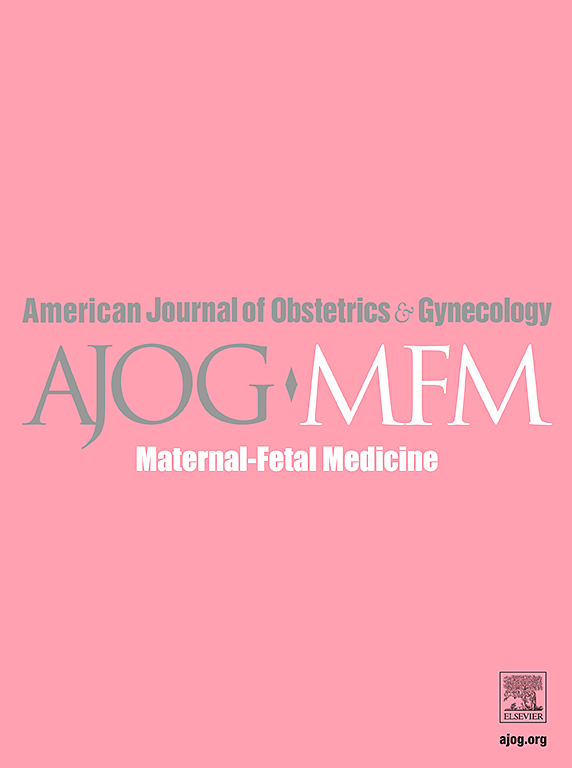在第二产程中将会阴部热敷与会阴按摩相结合能否减少会阴部创伤?随机对照试验:减少会阴创伤的热敷。
IF 3.1
2区 医学
Q1 OBSTETRICS & GYNECOLOGY
American Journal of Obstetrics & Gynecology Mfm
Pub Date : 2025-01-01
DOI:10.1016/j.ajogmf.2024.101547
引用次数: 0
摘要
背景:为了减少会阴创伤和产科肛门括约肌损伤(OASIS),人们采取了各种干预措施。第二产程热敷对减少会阴撕裂的效果尚存争议:我们旨在比较接受热敷加会阴按摩与单纯会阴按摩的产妇需要缝合的自发性会阴撕裂率:研究设计:2023 年 6 月至 2024 年 1 月期间,在一所大学附属三级医院住院的产妇被随机分配到第二产程中接受热敷和会阴按摩(206 人)或仅接受会阴信息(206 人)。有三度会阴撕裂史、坚果过敏、胎儿死亡、会阴受累的克罗恩病或分娩次数大于 5 的产妇被排除在外。在第二产程之前,参与者的分配是保密的。所分配的会阴处理在胎儿主动下降时和参与者感到需要用力时进行。在产妇积极用力时,两组研究人员都使用杏仁油对会阴部进行轻柔按摩。其中一组在宫缩间歇期进行热敷,时间最短 10 分钟,最长 30 分钟。热敷温度保持在 45-59°C 之间。在分娩过程中,会阴部由专人进行保护。分娩后,由干预盲法的高级助产士对会阴部进行评估,并进行直肠检查以排除 OASIS。主要结果是需要缝合的会阴撕裂率。次要结果包括OASIS和外阴切开率。根据胎次进行了子分析,并进行了意向治疗分析:结果:接受和未接受热敷治疗的产妇中,需要缝合自发性会阴撕裂的比例相似:43.7%对45.1%,P值=0.766。两组在一级裂伤比例(22.8% 对 21.4%,P 值=0.722)、二级裂伤比例(21.4% 对 23.8%,P 值=0.566)和 OASIS 发生率(各为 0.5%)方面没有差异。在根据胎次进行的子分析中,两组会阴撕裂的比例没有差异:结论:对于在第二产程中接受热敷和会阴按摩的产妇,与仅接受会阴按摩的产妇相比,需要缝合的自发性会阴撕裂率相似。视频摘要本文章由计算机程序翻译,如有差异,请以英文原文为准。
Does combining warm perineal compresses with perineal massage during the second stage of labor reduce perineal trauma? A randomized controlled trial
Background
Various interventions have been applied to reduce perineal trauma and obstetric anal sphincter injuries (OASIS). The efficacy of warm compresses during the second stage of labor for reducing the occurrence of perineal tears is controversial.
Objective
We aimed to compare rates of spontaneous perineal tears requiring suturing, between women who received warm compresses plus perineal massage vs perineal massage alone.
Study design
Women admitted to a single tertiary university-affiliated hospital between June 2023 and January 2024 were randomized to receive warm compresses and perineal massage (n=206) or perineal message only (n=206) during the second stage of labor. Excluded were women with a history of third-degree perineal tear, nut allergy, fetal death, Crohn's disease with perineal involvement, or delivery number >5. Participant allocation was concealed until the second stage of labor. The allocated perineal management was implemented at the time of active fetal descent and when the participant felt the need to push. During active maternal pushing, gentle perineal massage with almond oil was performed in both study groups. In 1 group, warm compresses were applied between contractions, for a minimum of 10 minutes and a maximum of 30. The temperature of the warm compresses was kept in the range of 45°C to 59°C. The perineum was protected during delivery with a hands-on technique. After delivery, the perineum was assessed by an intervention-blinded senior midwife and rectal examination was performed for ruling out OASIS. The primary outcome was the rate of perineal tears requiring suturing. Secondary outcomes included the rates of OASIS and episiotomies. A sub-analysis according to parity and an intention-to-treat analysis were performed.
Results
Similar proportions of women treated and not treated with warm compresses had spontaneous perineal tears requiring suturing: 43.7% vs 45.1%, P value=.766. The groups did not differ in the proportions with first-degree tears, 22.8% vs 21.4%, P value=.722; second-degree tears, 21.4% vs 23.8%, P value=.566; and OASIS rates, 0.5% in each. In a sub-analysis according to parity, the proportion with perineal tears did not differ between the 2 groups.
Conclusion
For women treated during the second stage of labor with warm compresses and perineal massage, compared to perineal massage alone, the rate of spontaneous perineal tears requiring suturing was similar.
El resumen está disponible en Español al final del artículo.
求助全文
通过发布文献求助,成功后即可免费获取论文全文。
去求助
来源期刊

American Journal of Obstetrics & Gynecology Mfm
Medicine-Medicine (all)
CiteScore
7.40
自引率
3.20%
发文量
254
审稿时长
40 days
期刊介绍:
The American Journal of Obstetrics and Gynecology (AJOG) is a highly esteemed publication with two companion titles. One of these is the American Journal of Obstetrics and Gynecology Maternal-Fetal Medicine (AJOG MFM), which is dedicated to the latest research in the field of maternal-fetal medicine, specifically concerning high-risk pregnancies. The journal encompasses a wide range of topics, including:
Maternal Complications: It addresses significant studies that have the potential to change clinical practice regarding complications faced by pregnant women.
Fetal Complications: The journal covers prenatal diagnosis, ultrasound, and genetic issues related to the fetus, providing insights into the management and care of fetal health.
Prenatal Care: It discusses the best practices in prenatal care to ensure the health and well-being of both the mother and the unborn child.
Intrapartum Care: It provides guidance on the care provided during the childbirth process, which is critical for the safety of both mother and baby.
Postpartum Issues: The journal also tackles issues that arise after childbirth, focusing on the postpartum period and its implications for maternal health. AJOG MFM serves as a reliable forum for peer-reviewed research, with a preference for randomized trials and meta-analyses. The goal is to equip researchers and clinicians with the most current information and evidence-based strategies to effectively manage high-risk pregnancies and to provide the best possible care for mothers and their unborn children.
 求助内容:
求助内容: 应助结果提醒方式:
应助结果提醒方式:


